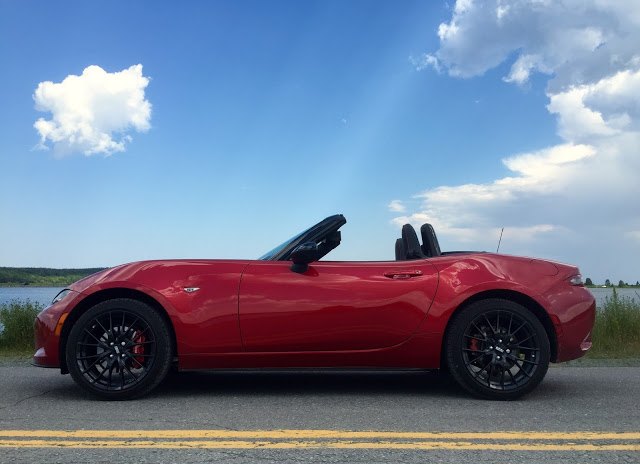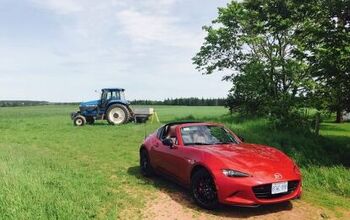My $1.8 Million Fleet in 2016 - the Good, the Bad, and the Ugly
Over the last year, the PR departments of 12 automobile manufacturers delivered 38 new vehicles to my driveway. Scheduling quirks and limited autumn availability saw that number slide from 2015, but week-long exposure to new vehicles was nevertheless extensive in 2016.
It’s a good gig. Sure, we work hard to maintain GoodCarBadCar.net — Mrs. Cain has even put in a fair number of hours since the October birth of our second baby boy — while I also contribute a couple of times per week to Autofocus.ca and work daily for The Truth About Cars. But in addition to our favored steed — the 2015 Honda Odyssey EX that we pay for with our own money — I get to drive (and fuel, and clean, and write two reviews about) a new automobile every week.
Those automobiles were collectively valued at $1.8 million in 2016, down from $2.2 million in 2015. The average price of the vehicles sent to GCBC Towers rose 4 percent to $46,671.
Every now and then, though less often than you’d think, I’d prefer a vehicle to hang around for an extra week. At least as often, I’d be content for vehicles to leave before their week was up. With the year now coming to a close, here are the best, the worst, the most surprising, the most disappointing, the most efficient, and the least economical vehicles I tested over the last year.
In 2016, Canada’s Maritime press fleet included one pickup truck, one roadster, two vans, seven sedans, three coupes, two wagons, eight hatchbacks, and 14 utility vehicles.
There were five hybrids, including a plug-in, and only four cars with manual transmissions. There was only one V8 engine; only seven V6s. 20 of the 38 powerplants were turbocharged.
Vehicles are hand-delivered to our driveway, but we don’t have any say in the selection or specification. It doesn’t work that way on Nova Scotia’s far flung east coast.
Best Of The Best: Mazda MX-5 Miata
It may be a painfully obvious choice, but the fourth-generation Mazda MX-5 Miata was by far the most fun I had all year. I’m in this business, rather than the business of measuring the linear feet of category space given to potato chips in grocery stores, because I enjoy driving. Over the last year, I drove vehicles with profoundly higher price tags than the MX-5’s. There was no shortage of cars with more power, more space, and more features.
But the Miata is better.
Honorable mentions: Volkswagen Golf R, Mercedes-Benz GLC300 4Matic, Audi A4
Biggest Surprise: Ford F-150 EcoBoost 2.7
Honorable mentions: Chevrolet Spark LS, Chevrolet Malibu 1.5T
Worst Of The Worst: Fiat 500X Trekking AWD
Honorable mentions: Honda HR-V EX-L and Audi Q3
Biggest Disappointment: Hyundai Veloster Turbo DCT
Honorable Mentions: Audi A3 e-Tron and Infiniti QX50
Most Efficient: Toyota Prius, 57 mpg
Ford C-Max SE (46 mpg) and Lincoln MKZ Hybrid Reserve (39 mpg)
Least Efficient: Acura MDX, 16 mpg
Honorable Mentions: GMC Yukon Denali (17 mpg) and Mercedes-Benz GLC300 4Matic (18 mpg)
THE CARS
Timothy Cain is the founder of GoodCarBadCar.net, which obsesses over the free and frequent publication of U.S. and Canadian auto sales figures. Follow on Twitter @goodcarbadcar and on Facebook.
More by Timothy Cain
Latest Car Reviews
Read moreLatest Product Reviews
Read moreRecent Comments
- Analoggrotto Does anyone seriously listen to this?
- Thomas Same here....but keep in mind that EVs are already much more efficient than ICE vehicles. They need to catch up in all the other areas you mentioned.
- Analoggrotto It's great to see TTAC kicking up the best for their #1 corporate sponsor. Keep up the good work guys.
- John66ny Title about self driving cars, linked podcast about headlight restoration. Some relationship?
- Jeff JMII--If I did not get my Maverick my next choice was a Santa Cruz. They are different but then they are both compact pickups the only real compact pickups on the market. I am glad to hear that the Santa Cruz will have knobs and buttons on it for 2025 it would be good if they offered a hybrid as well. When I looked at both trucks it was less about brand loyalty and more about price, size, and features. I have owned 2 gm made trucks in the past and liked both but gm does not make a true compact truck and neither does Ram, Toyota, or Nissan. The Maverick was the only Ford product that I wanted. If I wanted a larger truck I would have kept either my 99 S-10 extended cab with a 2.2 I-4 5 speed or my 08 Isuzu I-370 4 x 4 with the 3.7 I-5, tow package, heated leather seats, and other niceties and it road like a luxury vehicle. I believe the demand is there for other manufacturers to make compact pickups. The proposed hybrid Toyota Stout would be a great truck. Subaru has experience making small trucks and they could make a very competitive compact truck and Subaru has a great all wheel drive system. Chevy has a great compact pickup offered in South America called the Montana which gm could make in North America and offered in the US and Canada. Ram has a great little compact truck offered in South America as well. Compact trucks are a great vehicle for those who want an open bed for hauling but what a smaller more affordable efficient practical vehicle.







































Comments
Join the conversation
"Is the 3.5 EcoBoost even necessary?" You'd have to ask Ford engineers that question since the EB3.5 is their designated "go to" motor for any heavy lifting. It would be much more appropriate to ask, "Is the 3.5L Ti-VCT V6 or 5.0L Ti-VCT V8 even necessary?" The 5.0 (soon to be 4.8 V8) is necessary to keep the obnoxious driver and the aftermarket exhaust industry alive. LOL. The NA 3.5 is for the fleet industry. I doubt the 2.7 Turbo would fair well under the abuse of "I don't give a sh!t" fleet drivers and haphazard maintenance.
The general consensus appears to be that the MX5 is a super great car yet it's the only Mazda without The Schnoz. Significant?